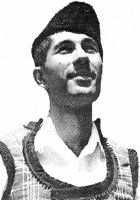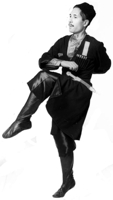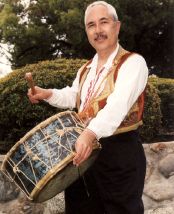|
Richard Unciano
|
|
CLICK AN IMAGE FOR LARGER VIEW
Richard Unciano was a dedicated teacher, accomplished performer, lecturer, researcher, author, and scholar of southeast European and Near Eastern traditional music and dance. He was based in Southern California.
Richard was born into a multi-ethnic family and raised in Los Angeles, California. He was deeply immersed in or involved with the "real, unadulterated heritages and cultures" of several local ethnic communities since his first exposure to these traditions as a child through his mother, a lifelong enthusiast of Russian and Hungarian gypsy music since the 1920s, and through his neighborhood friends (most of whom are Armenian). One of Richard's earliest memories was attending the wedding of a family friend who was marrying woman of Russian background. During his childhood, Richard studied violin.
Richard attended the University of California at Berkeley on a full academic scholorship, majoring in Sociology after switching from Engineering Physics. After Berkeley, he worked in San Francisco for two years and became acquainted with a number of authentic "belly dancers" through an Iranian woman where he worked. Early recreational folk dance inspiration and influences were Gordon Engler and Rubi Vučeta.
Richard taught courses at Los Angeles City College, California State Polytechnic University at Pomona, and Mount San Antonio College for many years. He also taught classes at Riverside Community College, Rio Hondo College, the American Armenian International College at La Verne, Saint Sarkis Armenian Apostolic Church A.C.Y.O. in Montebello, eight Los Angeles area Unified School Districts, Veselo Folk Dance Coffeehouse in Anaheim, Hadarim Folk Dance Center in Los Angeles, and The Intersection Folk Arts Center in Los Angeles, as well as innumerable master classes and workshops from San Diego to San Francisco to Las Vegas. Richard was the guest choreographer at numerous folk ensembles. His repertoire exceeded 1,300 dances and his personal collection of melodies was around 12,000.
Richard's associations included the Folk Dance Federation of California, South (Associate Member), Society for Ethnomusicology (Member), and the International Folk Music Council (Member).
 To increase and improve his learning and understanding, Richard undertook three field research expeditions (1964, 1967, and 1970) for a total of 23 months. He began teaching the material he learned after his first two tours in 1967. Richard worked with and through the Academy of Athens, Bulgarian Academy of Sciences Folklore Section, Sofia Conservatory of Music, Serbian Ethnographic Institute, Turk Folklor Kurumu, and many other scholarly institutions and universities. He had the instruction of hundreds of teachers from such prominent, recognized, and respected artistic and academic authorities, such as Vasileos Papachristos (Thessaloniki, Greece), Raina Katsarova (Sofia, Bulgaria), Dojcin Matevski (Skopje, Macedonia), and Radmila Petrović (Beograd, Serbia), to the very sources themselves (villagers, Gypsies, miners, etc.) who were acknowledged to be the best by their peers. During the many Armenian picnics, banquets, and weddings he attended, for example, he learned three versions of Tamzara, two kinds of Sepastia Bar, two variants of Pompouri, and 18 of the 41 step combinations (figures) of Lezginka. Also, some of the Los Angeles Armenian musicians willingly played melodies for him that were transcribed or notated. At Macedonian picnics, he even picked up a clapping variation to the standard Pajduško.
To increase and improve his learning and understanding, Richard undertook three field research expeditions (1964, 1967, and 1970) for a total of 23 months. He began teaching the material he learned after his first two tours in 1967. Richard worked with and through the Academy of Athens, Bulgarian Academy of Sciences Folklore Section, Sofia Conservatory of Music, Serbian Ethnographic Institute, Turk Folklor Kurumu, and many other scholarly institutions and universities. He had the instruction of hundreds of teachers from such prominent, recognized, and respected artistic and academic authorities, such as Vasileos Papachristos (Thessaloniki, Greece), Raina Katsarova (Sofia, Bulgaria), Dojcin Matevski (Skopje, Macedonia), and Radmila Petrović (Beograd, Serbia), to the very sources themselves (villagers, Gypsies, miners, etc.) who were acknowledged to be the best by their peers. During the many Armenian picnics, banquets, and weddings he attended, for example, he learned three versions of Tamzara, two kinds of Sepastia Bar, two variants of Pompouri, and 18 of the 41 step combinations (figures) of Lezginka. Also, some of the Los Angeles Armenian musicians willingly played melodies for him that were transcribed or notated. At Macedonian picnics, he even picked up a clapping variation to the standard Pajduško.
Singular accomplishments include being made an honorary member of the "Efxinos Leshi" Pontian Dance Group of Thessaloniki; teaching Turkish dances to Turks in Turkey; being a guest soloist at the 1970 reunion of Armenian communities of northern Greece in Kavala; being an honorary judge at the 1964 "Trakiia Pee" Folk Festival at Stara Zagora in Bulgaria; providing the music, costumes, and dance for the "Latka and Simka's Wedding" episode of the TV show Taxi,, appearing on Ralph Story's On Campus TV show with his class from the American Armenian International College (to demonstrate a dance); producing a fund-raising concert for the Orthodox Youth Center of Los Angeles; being selected to serve on the Los Angeles Mayor's Council for International Visitors and Sister Cities; and dancing with the Armenian Folkloric Dance Ensemble for seven years under the direction of Jora Makarian (he was the first non-Armenian to be invited and accepted into the group and only one of three such persons). Also of special note was Richard's effort to research, document, preserve, and present several endangered indigenous heritages, especially the Crimean Tatar minority and the Pontian Greek and Albanian (Shiptar) minority of Kosovo-Metohija and northern Macedonia.
To support himself and his activities, Richard was employed as an adult education teacher, engineering planner, production scheduler, materials buyer, and stock market analyst. These occupations, as with his other activities, also required disciplined research, thorough documentation, accurate data, interpersonal skills, and multi-tasking.
In 1971, Richard founded the KOROYAR Folklore Ensemble (the name was coined from the words kolo, horo, oyun, and bar), a unique, tightly-knit group of ten dancers that developed, presented, and perpetuated the traditional music of Southeast Europe and the Near East. This music has the distinctive feature of numerous asymmetric and uneven meters that are technically challenging and enigmatic. The ensemble's music also included the musically related Irish and Jewish heritages. The ensemble, co-directed by Richard and by Ron Muller, who made certain that all the proper embellishments, accidentals, accelerando changes, beat pattern variations, internal phrasing, "flavoring," etc. in each melody were employed -- tunes are not simplified and are all played at the proper tempo, with the proper rhythms from 2/4 to a double-compound 7/8 + 11/8, and propeer scales from major to modal to synthetic. The ensemble had hundreds of credits from university recitals to TV programs, and from international fairs to banquets, receptions, and weddings. The group's instrumentation included accordions, bass, cello, clarinet, percussion, and tambura. Richard himself played the hourglass-shaped drum called a dumbeg (a.k.a. darabuka, derbeke), the large double-headed drum called a tŭpan (aka tâpan, davul, daouli -- it is played with sticks), tambourine, and kashikler (Turkish spoons).
 Of Richard Unciano, Donna Tripp recalls, "I took lessons for a year with Richard when he was teaching at Veselo Selo back in the 1980s and I thoroughly respected his knowledge and dancing skill. Many, many years ago after Koroyar had been performing at the old Laguna Folkdancer's festival. I was standing around talking with Dick Crum. Dick asked about the guy, dressed all in black, who was dancing, according to Dick, an absolutely perfect version of a Bulgarian dance that Dick knew well. Did I know him? Well, it was Richard, and I took Dick over to meet him as soon as the dance concluded. The two men spent the next hour talking over in a corner of the gym. Dick was teaching at the festival that year."
Of Richard Unciano, Donna Tripp recalls, "I took lessons for a year with Richard when he was teaching at Veselo Selo back in the 1980s and I thoroughly respected his knowledge and dancing skill. Many, many years ago after Koroyar had been performing at the old Laguna Folkdancer's festival. I was standing around talking with Dick Crum. Dick asked about the guy, dressed all in black, who was dancing, according to Dick, an absolutely perfect version of a Bulgarian dance that Dick knew well. Did I know him? Well, it was Richard, and I took Dick over to meet him as soon as the dance concluded. The two men spent the next hour talking over in a corner of the gym. Dick was teaching at the festival that year."
Loren Lichty writes, "Richard grew up in a neighborhood in Hollywood that had a very high Armenian population. He was adopted by his neighbors as a member of their community. As a result, Richard grew up listening to Armenian music, and learning Armenian dances from his neighbors and friends. This is what sparked Richard's interest in Balkan and Near Eastern music and dance. In order to share the things he had learned with his friends and the public at large, he started Koroyar. While there have been many changes in personnel over the years, Koroyar has been in continuous existence since, I believe, 1969. During the 1970s and most of the 1980s, Richard taught folk dancing through community services courses at local community colleges (Los Angeles City College, Mt. San Antonio College, and Rio Hondo College). Richard was one of the best dance teachers that I have ever met. He had a remarkable ability to break a dance down to it's component parts, and to relate the similarities between dances. He was also (infamously so) a stickler for style, and, in my opinion, had the most complete understanding of what makes one region's style different from another's. That was how I met Richard. I had started folk dancing in high school. After high school, I started taking classes at LACC (but not Richard's). This was during the time when Mario Casetta was organizing those incredible folk dance / music festivals for (Radio Station) KPFK. I started noticing Koroyar performing at those festivals, and was intrigued by their repetoire. They were doing unusual dances that I wasn't seeing elsewhere, and also some familiar dances, but done differently than I was used to. When I learned that Richard was teaching through LACC's community services, I decided to take one of his classes. Despite my two left feet (I've improved since then), and my penchant for really bad puns (actually, probably because of it), he invited me to join Koroyar. It literally changed my life, and I've been a member ever since."
Richard passed away on April 8, 2006, of colon cancer, which was discovered at a late stage, taking him quickly.
Among Richard's articles and publications are:
- "Adventures in Costume Hunting."
- "Bar' Hopping in Turkey." An introduction to the dances of Erzurm province.
- "Buchimish." A dance of Pazardzhik county in Bulgarian Thrace.
- "Dining a la Ethnic in Los Angeles - Afghan."
- "Dobrudzhan Dances." An introduction to the traditional dances of N.E. Bulgaria.
- "Gankino, Kopanitsa and More in 11/16."
- "Hora." The origin of the term.
- "Koleduvane." Description of Bulgarian Christmas caroling.
- "LAZ: Pontian Greek Dances." An Introduction to the dances of the Black Sea Greeks.
- "A Marvelous Macedonian Wedding." Describing a three-day wedding.
- "Must Reading: Greek Costumes."
- "Must Reading: Greek Dances."
- "My Pontian Muse."
- "Sheikhani." A dance of the Assyrian Christian minority of western Iran.
- "Shope Dances A to Z." An expansion of his "Shope Dances of Bulgaria."
- "Shope Dances of Bulgaria." An introduction to the traditional dances of western Bulgaria.
- "Where There's Dance, There's Hope."
- "Zagorissios." A dance of Greek Epirus.
Dances Richard taught included Bučimiš, Čukanoto, Gaida, Gankino (Kopanica), Jeni jol, Kotsari, Krivko, Kjustendilska lesa, Mŭžka šopsko horo, Omal Kotsiton, Omal Thipat, O Menousis, Ovčepolsko potrčulka, Pembe, Petrunino horo, Pravo Trakiisko horo, Rŭka, Sheikhani, Svornato, Syrto Kofto, Syrto Roditikos, Tik, Trite pŭti, Tropanka, and Zagorissios.
